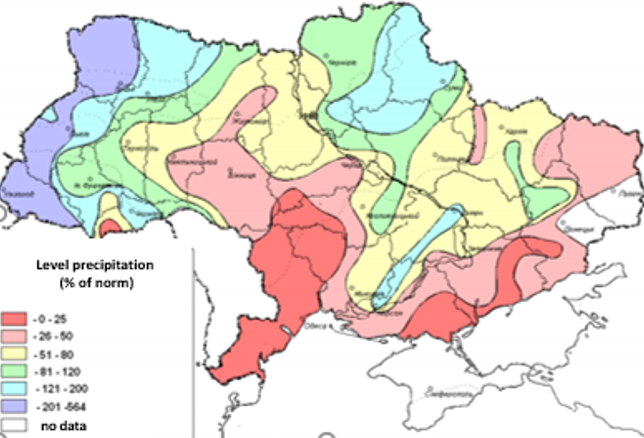The average air temperature in the Zaporizhzhya, Donetsk, Luhansk, Sumy, Rivne, Volyn, Lviv, Ternopil, Ivano-Frankivsk and Transcarpathian regions ranged from 7.0 °С to 12.5 °С in the first ten days of November. The maximum air temperature increased to 17-22 °C, and in the southern, Kirovograd, Vinnytsya and Chernivtsi regions – up to 23-25 °C.
Precipitation of varying amounts and intensities was observed for 1-9 days throughout most the country. Their average regional number in the Odessa, Mykolayiv, Zaporizhzhya, Donetsk and Luhansk regions ranged from 9 to 50% of the ten-day norm (1-6 mm), in the southern regions of the Odessa region there was no precipitation at all. In the Kherson, Dnipropetrovsk, Kharkiv, Kirovograd, Cherkasy, Vinnytsya and Khmelnitsky regions fell from 55 to 75% of the ten-day rainfall rate (6-8 mm). Near normal rainfall of 8-16 mm was noted in the Poltava, Chernihiv, Kyiv, Zhytomyr, Ternopil, Ivano-Frankivsk and Chernivtsi regions.

Warm weather contributed to the resumption and continuation of the active vegetation of winter crops. Due to the fact that in some areas the crops were late, the high air temperature as for November greatly contributed to the improvement of the phase development of winter crops. In regions where there was an increase in moisture reserves, tillering and the formation of nodal roots began in a number of areas. In areas where precipitation was insufficient to replenish the moisture reserves of the soil, warm, humid weather, fogs and drizzle, light precipitation on certain days had a positive effect on crops, but there was no active development due to deficit of soil moisture. The most favorable conditions were in the western and northern regions, where there were effective rains. As of November 10, the best winter crops (visual state and phase development), including rape, were observed in the Dnipropetrovsk, Kherson, Kharkiv, Zhytomyr regions. The least favorable agrometeorological conditions for the growth and development of winter crops due to a deficit of productive moisture in the soil were observed in the Odessa and Cherkasy regions. In the Cherkasy region, the situation has become critical, the duration of soil drought has increased to 99-160 days. In most areas formed seedlings were liquefied and spotted, there are cases of plowed crops. Warm weather contributed to the deterioration of the phytosanitary condition of the fields which caused the activation of pests, fungal diseases, weeds, the migration of mouse-like rodents to winter crops and perennial grasses.